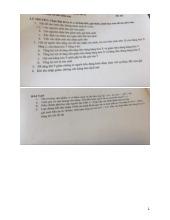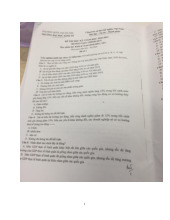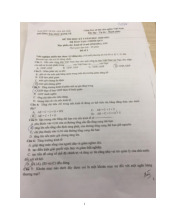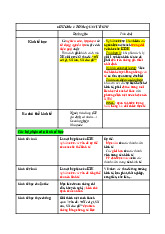







Preview text:
Specialized microeconomics Multiple choice questions:
1) As long as the principle of diminishing marginal utility is operating, any increased consumption of a good a.lowers total utility.
b.produces negative total utility.
c.lowers marginal utility and, therefore, total utility.
d.lowers marginal utility, but may raise total utility.
2) Among all the combinations of goods attainable by a consumer, the one that maximizes total utility is the one that
a.maximizes the marginal utilities per dollar of each good.
b.maximizes the marginal utilities per pound (or other physical unit) of each good.
c.equates the marginal utilities per dollar of each good.
d.equates the marginal utilities per pound (or other physical unit) of each good
3) A utility contour (or indifference curve) shows all the alternative combinations of two consumption goods that
a.can be produced with a given set of resources and technology.
b.yield the same total of utility.
c.can be purchased with a given budget at given prices.
d.equate the marginal utilities of these goods and, therefore, make the consumer indifferent between them.
4.Which of the following is a correct representation of the budget constraint in a world with only
food and shelter, where M = income, P = price of food, P = shelter price, S = the quantity of
shelter, and F = the quantity of food. F.P + P.S = M a.M = P(S) + P(F) b.F = M/P - P/P(S) c.S = M/P - P/P(F) d.F = M(P) + P/P(S) e.None of the above is correct
5.All points on or below a budget constraint
a.are attainable with the given income. b.are equally desirable.
c.represent market basket combinations that exhaust the income available.
d.are described, in part, by a, b, and c above
6.Indifference curves that intersect would be illogical constructs because a.more is better than less.
b.of diminishing marginal utility.
c.of the transivity property of indifference theory. d.of both a and c above. e.of none of the above.
7. Production function has type: Q = 2K.(L-2). Marginal rate of technological substitution (MRTS) equals: A. B. K.(L-2) C. L-2 D. None of the above
8. Suppose that a firm’s production function is given by Q = 6KL, where K is capital and L is
labor. What is the marginal product of labor when 6 units of capital are employed? a. 48. b. 6. c. 36. d. 1. e. none of the above.
9. Long distance carriers AT&T and MCI are attempting to move into the market for local
telephone service in order to exploit a. economies of scale. b. diseconomies of scale. c. economies of scope. d. diseconomies of scope.
e. diminishing returns to capital
10. The firm’s total cost of producing 10 units of output is 120. At this output level, the firm’s fixed costs
are equal to 40. It follows that the firm’s average variable costs are equal to a. 12. b. 6. c. 8. d. 4. e. none of the above. consider a consumer choosing between good X and good Y. The consumer’s
11. Consider a consumer choosing good X and good Y. Utility function of consumer: U= X0.5 +4Y0.5, and
his budget constraint: 2X + 4Y = M. Where M is consumer’s income. What’s optimal ratio of purchased
units of good X and good Y for consumer? a. Y*= 4X* b. Y* =16X* c. Y*= 32X* d. None of the above
12. The Cournot equilibrium theory of oligopoly assume that:
A. rivals will increase their output whenever a firm increase its output
B. rivals will keep their output constant
C. rivals will increase output whenever a firm increase its output
D. rivals will follow the learning curve
13. Which of the following are quantity setting oligopoly models? A. Cournot B. Stackelberg C. Betrand D. a and b
14. Which of the following is a profit-maximizing condition for a Cournot oligopolist? A. P= MR B. MR=MC C. Q1 = Q2 =…= Qn D. P=MC
15. A new firm enters a market which is initially serviced by a Bertrand duopoly charging the price of
$20. What will the new price be should the three firms co-exist after the entry? A. $25 B. $20 C. $15 D. None of the above
16. A monopoly market is characterized by a. many buyers and sellers. b. natural products. c. barriers to entry. d. a Nash equilibrium. 17. A benefit of a monopoly is a. lower prices.
b. a wide variety of similar products.
c. decreasing long-run average total costs.
d. greater creativity by inventor who can register his patent.
18. The oligopolistic market has 2 firms. Suppose the linear demand curve function: D(p) = 50−8p. The
marginal cost of each firms equals zero. In Cournot model, the reaction curve of firm 1: a. y = 1 b. y1= c. y = 1 d. y1=
19. With the same conditions as 18) question, the output of Cournot equilibrium for both firms: a. y = y 1 2 = 12. 1. The Cournot the b. y1 = y2 = c. y = y 1 2 = 25 d. y1 = y2 =
20. The oligopolistic market has 2 firms. Suppose the linear demand curve function: D(p) =
33−8p. The marginal cost of each firm equals zero. In Stackelberg model, the total output of the industry: a. 66 b. c. d. None of the above
21. With the same conditions as 20) question. Suppose also firm 1 is the first mover. The output
of Stackelberg equilibrium for firm 2 as a quantity follower: a. 11 b. c. d. None of the above
22. In case of constant-elasticity demand curve, with �=-2, MC=4. A monopolist will charge a markup price at: a. 6 b. 8 c. 4 d. 12
23. What is the major assumption that characterizes a purely competitive market?
a. That all firms in the industry take the market price as given.
b. There are interventions from the government
c. The products of firms are slightly different d. None of the above
24. In pure competition, if the supply curve is given by S(p) = 100 + 20p, what is the formula for the inverse supply curve? a. Ps(y) = (y − 100)/20. b. Ps(y) = (100-y)/20 c. Ps(y) = (y − 100)/40 d. None of the above
25. Pareto efficient cannot exist in the situation which has: a. Exchange economy b. Pure competition c. Perfect competition d. Oligopolistic market
26. In the exchange economy, Mark and John both produce and consume 2 goods achiving
Pareto efficient allocation in both consumption and production. What formula shows this curcumstance? a. MRS = MRT b. MRSMark = MRSJohn c. MRS > MRT d. Both A and B are true
27. Which of the following statement is true?
a. It is possible to have a Pareto efficient allocation where everyone is worse off than they are at
an allocation that is not Pareto efficient
b. It is possible to have a Pareto efficient allocation where someone is worse off than he is at an
allocation that is not Pareto efficient c. Both A and B are true d. Both A and B are false
28. What kind of price discrminination may achieve Pareto efficiency? a. 1st degree b. 2nd degree c. 3rd degree d. None of them
29. Which of the following statement is true ?
a. Monopolistic competition can result in too much or too little product differentiation
b. If a firm can charge different prices in two different markets, it will tend to charge the lower
price in the market with the more elastic demand.
c. If a firm can set a two-part tariff, and consumers are identical, then it will generally want to set
price equal to marginal cost and make all of its profits from the entry fee d. All statments are true
30. If the value of excess demand in 8 out of 10 markets is equal to zero, what must be true about the remaining two markets?
a. The value of excess demand in the remaining two markets must sum larger than zero
b. The value of excess demand in the remaining two markets must sum to zero.
c. The value of net demand in the remaining two markets must be equal d. None of the above




